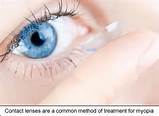Eye disease - Myopia (Nearsightedness):
Introduction to myopia
Myopia (or nearsightedness) affects 20% to 30% of the population, but this eye disorder is easily corrected witheyeglasses, contact lenses or surgery.
People who have myopia or nearsightedness have difficulty seeing distant objects, but can see objects that are near clearly. For example, a person who is nearsighted may not be able to make out highway signs until they are just a few feet away.
What Causes Myopia?
People who are nearsighted have what is called a refractive error. This means that the light rays bend incorrectly into the eye to transmit images to the brain. In people with myopia, the eyeball is too long or thecornea has too much curvature, so the light entering the eye is not focused correctly. Light rays of images focus in front of the retina, the light-sensitive part of the eye, rather than directly on the retina, causing blurred vision.
Myopia runs in families and usually appears in childhood. Sometimes the condition plateaus, or sometimes it worsens with age.
What Are the Symptoms of Myopia?
People who are nearsighted often complain of headaches, eyestrain, squinting or fatigue when driving, playing sports, or looking more than a few feet away.
How Is Myopia Diagnosed?
Myopia can be easily diagnosed using standard eye exams given by an eye doctor.
How Is Myopia Treated?
Glasses, contact lenses, or refractive surgery can correct myopia.
With myopia, your prescription for glasses or contact lens is a negative number, such as -3.00. The higher the number, the stronger your lenses will be.
Refractive surgery can reduce or even eliminate your dependence on glasses or contact lenses. The most common procedures for myopia are performed with a laser, including:
- Photorefractive keratectomy. Also called PRK , a laser is used to remove a layer of corneal tissue, which flattens the cornea and allows light rays to focus closer to or even on the retina.
- Laser-assisted in situ keratomileusis.Commonly called LASIK , a laser is used to cut a flap through the top of the cornea, a laser removes some corneal tissue, then the flap is dropped back into place. LASIK is the most common surgery used to correct nearsightedness.
- Corneal rings. Plastic corneal rings, called Intacs, are implanted into the eye to alter the shape of the cornea. One advantage of the rings is that they may be left in place permanently, may be removed in case of a problem, or adjusted should a prescription change be necessary.
Photo Gallery:








No comments:
Post a Comment